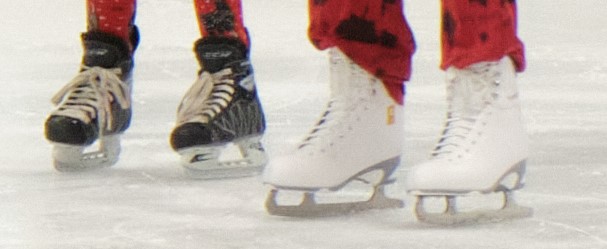
... more about skates
Proper equipment is essential to becoming skilled in most sports and skating is no exception. One of the common concerns of coaches working with beginners is poor equipment.
Proper fitting figure skates (or hockey skates if in the CanSkate program), with good support, laced correctly and sharpened regularly (new skates in the box have not been sharpened; they will need to be sharpened before your first lesson), help the skater maintain control on the ice - therefore less chance of falling. Children cannot learn skills such as balancing on one foot unless the skating boots fit well and support the ankles.
Hockey skates or figure skates?
- If you have an idea of what direction your child would like to go in (hockey/figure skating), pick a skate appropriate to that sport. It is more difficult to re-learn in the opposite style but not impossible.
- If your skater is very young with very small feet, look for a skate that does not have a big rocker (curve along the length of the blade). Figure Skates or the recreational “Softek” have longer, flatter blades for those first steps.
- If you are unsure of whether or not your child will like skating, by all means, use the hand-me-downs available to you.
- Leisure skates with a hard plastic exterior, buckles, clips or dials to tighten or size adjustable skates are neither figure skates nor hockey skates and are NOT recommended.
Where can I purchase skates?
- Sports Experts - 1080 Railway Avenue, Canmore (new skates)
- Canadian Tire- Gateway Avenue, Canmore (new skates)
- Switching Gear – 718 10th St, Canmore (used Skates)
- Professional Skate Service, Marda Loop Calgary (new and used) – www.psscalgary.com
- The Skate Lab, near Chinook Shopping Centre, Calgary - https://theskatelab.com/
Proper fit:
- Boots should be fitted with one pair of socks only. There should be room to move the toes but the foot should not slide around. The maximum amount of space between the toes and the end of the boot should be 1/2" or 1.3cm.
- A good idea is to take the liner out of the skate and have your child stand on the liner. This way you can see how much room there is at the end of the skate.
- Skates should fit snugly around the ankles and heels.
- There should be some room for movement but the ankle, instep, and heel must be firmly supported.
- The skater should be able to bend his/her knees and ankles, enough so that you can run your finger between their Achilles tendon and the skate boot.
- The tongue should be sufficiently wide so that it will stay in place and it should be well padded to prevent laces from cutting into the foot.
- The front opening of the boot should be sufficiently wide to pull the laces tight.
Proper care:
- Be sure to wear skate guards and stay on black rubber matting when off the ice. Walking on concrete or metal will damage your blades.
- After skating, wipe blades off with a clean, dry cloth and wrap blades in a small towel or put soft blade covers on to prevent rusting.
- When back home, unzip your skate bag so that your skates can dry completely.
- New skates will need to be sharpened before they are used and used skates may not have seen a sharpening in a while. If you care for your skates, you can get up to 50 hours of skating out of a sharpening.
- If you do a lot of outdoor skating you will need more frequent sharpening.
- Sports Experts can take care of your sharpening needs. If you have figure skates ask them NOT to sharpen off the bottom toe pick or swoop the heel up like a rockered hockey blade.
Lacing Skates:
- Skates should be laced fairly loosely over the toe and front of the foot but gradually fitting a bit more snugly as you lace up over the ankle.
- Figure skates are softer than hockey skates and if tied too tightly, may seriously restrict movement.
- Some hockey skates are very stiff and it takes good leverage and muscle power to get them tight enough.
- When the skater walks in his or her skates their ankles should be upright, if dropping to the inside or out, or wobbling from one side to the other they are not tied tight enough.
- If the skater cannot bend their ankles then skates are tied too tightly.
**It might take some practice to get this just right. Often children under the age of 9 cannot tie their own skates. Please be prepared to help your child lace his or her skates.
ONE OF MY FAVOURITE RECOMMENDATIONS:
Find some time to allow for your child to get dressed in his her skating equipment and let them play. If you have a room in your house with older carpet, put on those hard skate guards or masking tape on the blades to protect your floors. Put some music on and let them dance in their skates and helmet and/or give them a mini stick or a ball and play hockey or soccer or catch. If your house does not allow this space, come to the rec-centre get geared up and just play or walk on the black matting. The more children become comfortable with this new equipment without adding the element of that slippery, cold ice, the more they will adjust to the world of skating.
If you have further questions regarding becoming equipped for CanSkate, please contact our CanSkate Program Coordinator by emailing canmoreskatingclub@gmail.com
Bottom Content Title
This is an additional section to be able to add content


